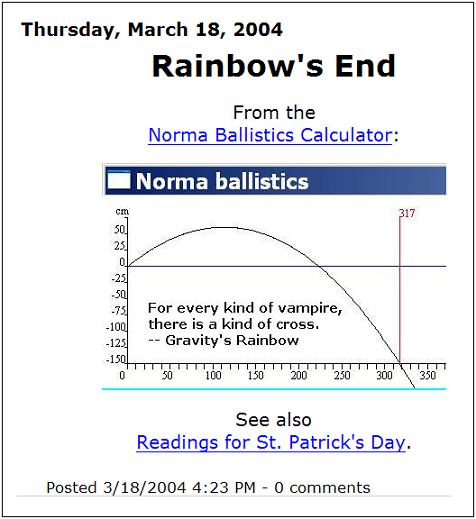For the title, see the Aug. 17 post Vampire Workday.
Scholium for Beckinsale —
“For every kind of vampire, there is a kind of cross.” — Gravity’s Rainbow
For the title, see the Aug. 17 post Vampire Workday.
Scholium for Beckinsale —
“For every kind of vampire, there is a kind of cross.” — Gravity’s Rainbow
See the tag on050528.
This tag was suggested by Google's pitch today —
Relive 10 epic years of YouTube.
Or not.
See as well Trouble with the Curve —
“For every kind of vampire, there is a kind of cross.” — Gravity’s Rainbow
“I don’t write exclusively on Jewish themes or about Jewish characters.
My collection of short stories, Strange Attractors , contained nine pieces,
five of which were, to some degree, Jewish, and this ratio has provided me
with a precise mathematical answer (for me, still the best kind of answer)
to the question of whether I am a Jewish writer. I am five-ninths a Jewish writer.”
— Rebecca Goldstein, “Against Logic”
Related material: The cross of five ninths, from Epiphany 2006.
In memory of art historian John Golding,
whose obituary appeared (finally) in
today’s online Telegraph—
“His most recent book, Paths to the Absolute (based on
his 1997 series of AW Mellon lectures in the Fine Arts
delivered at the National Gallery of Art, Washington DC),
addressed seven abstract artists — Mondrian, Kazimir
Malevich, Kandinsky, Pollock, Barnett Newman, Rothko
and Clyfford Still — and argued that abstract art was
not simply decorative but ‘heavily imbued with meaning
[and] with content’. The book won the Mitchell Prize for
the History of Art in 2002.”
Commentary on Golding’s obituary suggested by
this evening’s 4-digit New York Lottery number,
1051—
Post 1051 in this journal, together with a post from
April 1, 2012 found in a search for the digits 1051
in Log24. That search may serve as a review.
* A phrase from Gravity’s Rainbow
Unitarian Universalist Origins: Our Historic Faith—
“In sixteenth-century Transylvania, Unitarian congregations were established for the first time in history.”
Gravity’s Rainbow–
“For every kind of vampire, there is a kind of cross.”
Unitarian minister Richard Trudeau—
“… I called the belief that
(1) Diamonds– informative, certain truths about the world– exist
the ‘Diamond Theory’ of truth. I said that for 2200 years the strongest evidence for the Diamond Theory was the widespread perception that
(2) The theorems of Euclidean geometry are diamonds….
As the news about non-Euclidean geometry spread– first among mathematicians, then among scientists and philosophers– the Diamond Theory began a long decline that continues today.
Factors outside mathematics have contributed to this decline. Euclidean geometry had never been the Diamond Theory’s only ally. In the eighteenth century other fields had seemed to possess diamonds, too; when many of these turned out to be man-made, the Diamond Theory was undercut. And unlike earlier periods in history, when intellectual shocks came only occasionally, received truths have, since the eighteenth century, been found wanting at a dizzying rate, creating an impression that perhaps no knowledge is stable.
Other factors notwithstanding, non-Euclidean geometry remains, I think, for those who have heard of it, the single most powerful argument against the Diamond Theory*– first, because it overthrows what had always been the strongest argument in favor of the Diamond Theory, the objective truth of Euclidean geometry; and second, because it does so not by showing Euclidean geometry to be false, but by showing it to be merely uncertain.” —The Non-Euclidean Revolution, p. 255
H. S. M. Coxeter, 1987, introduction to Trudeau’s book—
“There is a pleasantly discursive treatment of Pontius Pilate’s unanswered question ‘What is truth?’.”
As noted here on Oct. 8, 2008 (A Yom Kippur Meditation), Coxeter was aware in 1987 of a more technical use of the phrase “diamond theory” that is closely related to…

“For every kind of vampire,
there is a kind of cross.”
— Thomas Pynchon in
Gravity’s Rainbow
“Since 1963, when Pynchon’s first novel, V., came out, the writer– widely considered America’s most important novelist since World War II– has become an almost mythical figure,
— Nancy Jo Sales in the November 11, 1996, issue of New York Magazine
(Click on images for their
source in past entries.)
In a Nutshell:
“Plato’s Ghost evokes Yeats’s lament that any claim to worldly perfection inevitably is proven wrong by the philosopher’s ghost….”
— Princeton University Press on Plato’s Ghost: The Modernist Transformation of Mathematics (by Jeremy Gray, September 2008)
|
Click to enlarge.
From another place:
“… a kind of cross.”
— Gravity’s Rainbow
— Thomas Pynchon in
Gravity’s Rainbow
This entry is continued
from yesterday evening,
from midnight last night,
and from an entry of
February 20 (the date
four years ago of
Hunter Thompson’s death)–
“Emblematizing the Modern“–
|
Emblematizing the Modern
Note that in applications, the vertical axis of the Cross of Descartes often symbolizes the timeless (money, temperature, etc.) while the horizontal axis often symbolizes time. T.S. Eliot:
|
“Selah.”
— The late Hunter Thompson

Yesterday afternoon’s online
New York Times:

Today’s online New York Times:
Footnote

“For every kind of vampire,
there is a kind of cross.”
— Gravity’s Rainbow

The above text on Joyce’s theory of epiphanies:
“It emphasizes the radiance, the effulgence, of the thing itself revealed in a special moment, an unmoving moment, of time. The moment, as in the macrocosmic lyric of Finnegans Wake, may involve all other moments, but it still remains essentially static, and though it may have all time for its subject matter it is essentially timeless.”
— Page 17 of Stephen Hero, by James Joyce, Theodore Spencer, John J. Slocum, and Herbert Cahoon, Edition: 16, New Directions Publishing, 1963
Related epiphanies —


“Joyce knew no Greek.”
— Statement by the prototype
of Buck Mulligan in Ulysses,
Oliver St. John Gogarty,
quoted in the above
New Directions Stephen Hero
“Chrysostomos.”
— Statement in Ulysses
by the prototype
of Stephen Dedalus,
James Augustine Aloysius Joyce
See also the link to
Mardi Gras, 2008,
in yesterday’s entry,
with its text from
the opening of Ulysses:
“He faced about and
blessed gravely thrice
the tower,
the surrounding country
and the awaking mountains.”
Some context:
(Click on images for details.)
and
“In the process of absorbing
the rules of the institutions
we inhabit, we become
who we are.”
— David Brooks, Jewish columnist,
in today’s New York Times
The Prisoner,
Episode One, 1967:
“I… I meant a larger map.”

“… while some are elected,
others not elect are
passed by….”
— A commentary on the
Calvinist doctrine of preterition
| Gravity’s Rainbow, Penguin Classics, 1995, page 742:
“… knowing his Tarot, we would expect to look among the Humility, among the gray and preterite souls, to look for him adrift in the hostile light of the sky, the darkness of the sea…. Now there’s only a long cat’s-eye of bleak sunset left over the plain tonight, bright gray against a purple ceiling of clouds, with an iris of 742″ |
“God is the original
conspiracy theory.”
“We remain a young nation, but in the words of Scripture, the time has come to set aside childish things.”
— President Obama yesterday
It is not entirely clear what these “childish things” are. Perhaps the young nation’s “childish things” that the new President refers to are part of what Robert Stone memorably called “our secret culture.” Stone was referring to Puritanism, which some advocates of the new religion of Scientism might call “childish.” I do not. Lunatic, perhaps, but not childish.
Related meditations:
A year ago yesterday, on Sunday, Jan. 20, 2008, the mid-day lottery for New York State was 605.
A midrash in the Judeo-Christian tradition of paranoia a year ago today suggested that 605 might be a veiled reference to “God, the Devil, and a Bridge,” a weblog entry on mathematician André Weil.
Continuing in this vein a year later, we are confronted with the mid-day New York lottery for yesterday:
Taking a hint from another
entry on Weil, this may be
regarded as a reference to
The Oxford Book of
English Verse (1919 edition):
Selection 742 in that book
comports well with this
jounal’s recent meditations
on death and Brooklyn:
| “Let me glide noiselessly forth; | |
| With the key of softness unlock the locks….” — Walt Whitman |
Applying this method of
exegesis to last year’s
lottery, we have
| “And all that did then attend and follow, |
|
| Were silent with love, as you now, Apollo, |
|
| With envy of my sweet pipings.” |
— Pan: God of Shepherds, Flocks, and Fornication
Hymn 605 thus supplies a reference to the devil mentioned by Weil in the entry of 6/05.
“… thus far, I have not heard any priests of Apollo, nor of any other God, issuing any auguries.”
Neither have I, but hearing is only one of the senses.
“Heard melodies are sweet,
but those unheard
Are sweeter.”— John Keats
| Finland MSIE |
/72725902/ | google.fi | 9/7/2008/ 1:59 PM |

A eulogy for the late
editor Robert Giroux:
Readers of the previous entry
who wish to practice their pardes
may contemplate the following:

Christ and the Four Elements
This 1495 image is found in
The Janus Faces of Genius:
The Role of Alchemy
in Newton’s Thought,
by B. J. T. Dobbs,
Cambridge University Press,
2002, p. 85
Related mandalas:
and
For further details,
click on any of the
three mandalas above.
“For every kind of vampire,
there is a kind of cross.”
— Thomas Pynchon, quoted
here on 9/13, 2007
Time of entry: 10:20:55 PM
The conclusion of yesterday’s commentary on the May 30-31 Pennsylvania Lottery numbers:
Thomas Pynchon, Gravity’s Rainbow:
“The fear balloons again inside his brain. It will not be kept down with a simple Fuck You…. A smell, a forbidden room, at the bottom edge of his memory. He can’t see it, can’t make it out. Doesn’t want to. It is allied with the Worst Thing.
He knows what the smell has to be: though according to these papers it would have been too early for it, though he has never come across any of the stuff among the daytime coordinates of his life, still, down here, back here in the warm dark, among early shapes where the clocks and calendars don’t mean too much, he knows that’s what haunting him now will prove to be the smell of Imipolex G.
Then there’s this recent dream he is afraid of having again. He was in his old room, back home. A summer afternoon of lilacs and bees and
286”
What are we to make of this enigmatic 286? (No fair peeking at page 287.)
One possible meaning, given The Archivist‘s claim that “existence is infinitely cross-referenced”–
Page 286 of Ernest G. Schachtel, Metamorphosis: On the Conflict of Human Development and the Psychology of Creativity (first published in 1959), Hillsdale NJ and London, The Analytic Press, 2001 (chapter– “On Memory and Childhood Amnesia”):
“Both Freud and Proust speak of the autobiographical [my italics] memory, and it is only with regard to this memory that the striking phenomenon of childhood amnesia and the less obvious difficulty of recovering any past experience may be observed.”
The concluding “summer afternoon of lilacs and bees” suggests that 286 may also be a chance allusion to the golden afternoon of Disney’s Alice in Wonderland. (Cf. St. Sarah’s Day, 2008)
Some may find the Disney afternoon charming; others may see it as yet another of Paul Simon’s dreaded cartoon graveyards.
More tastefully, there is poem 286 in the 1919 Oxford Book of English Verse– “Love.”
For a midrash on this poem, see Simone Weil, who became acquainted with the poem by chance:
“I always prefer saying chance rather than Providence.”
— Simone Weil, letter of about May 15, 1942
Weil’s brother André might prefer Providence (source of the Bulletin of the American Mathematical Society.)
 (Photo from Providence)
(Photo from Providence)

For more on the mathematical significance of this figure, see (for instance) Happy Birthday, Hassler Whitney, and Combinatorics of Coxeter Groups, by Anders Björner and Francesco Brenti, Graduate Texts in Mathematics, vol. 231, Springer, New York, 2005.
This book is reviewed in the current issue (July 2008) of the above-mentioned Providence Bulletin.
The review in the Bulletin discusses reflection groups in continuous spaces.
The New York Times,
Thursday, September 13, 2007–
Burt Hasen, Artist Inspired
by Maps, Dies at 85
Burt Hasen, a New York painter who drew inspiration from his experience working with maps as a military technician during World War II, died on Friday [September 7, 2007] in Manhattan. He was 85 and lived in Lower Manhattan….
During the war he served in the Air Force in the Pacific, where his duties involved close study of aerial maps, an activity that lastingly influenced his work. His densely worked canvases often had an overhead perspective….Toward the end of his life, many of his seemingly abstract paintings were based directly, and in detail, on maps….
In 2006 Mr. Hasen, his wife and the other tenants of a five-story building at 7 Dutch Street near the South Street Seaport made news when they organized against their landlord’s attempt to evict them from the rent-regulated lofts they had occupied for more than 30 years. They subsequently had their leases renewed.

“For every kind of vampire,
there is a kind of cross.”
— Gravity’s Rainbow

Related material from March 2004:
Anschaulichkeit (3/16) and
Readings for St. Patrick’s Day.
“For every kind of vampire,
there is a kind of cross.”
— Thomas Pynchon,
Gravity’s Rainbow


Hypercube and Cube

For every kind of vampire,
there is a kind of cross.
— Gravity’s Rainbow

Kate Beckinsale, poster for
Underworld: Evolution
(DVD release date 6/6/6)
evolve:
1641, “to unfold, open out, expand,”
from L. evolvere “unroll,” from ex- “out”
+ volvere “to roll” (see vulva).
— Online Eymology Dictionary
Related material:
Introduction to Multispeech,
All Hallows’ Eve, 2005
Google Maps image
of the isle of Delos,
birthplace of Apollo:

“I faced myself that day with
the nonplused apprehension
of someone who has
come across a vampire
and has no crucifix in hand.”
— Joan Didion, “On Self-Respect,”
in Slouching Towards Bethlehem
“For every kind of vampire,
there is a kind of cross.”
— Thomas Pynchon,
Gravity’s Rainbow

Related material:
From today’s online
Harvard Crimson:

From an Amazon.com review
of McCafferty’s latest book:
— and an entry of April 8
that contains the following
“kind of cross” —
3 PM
Good
Friday

“‘Lestat,’ the maiden Broadway production of Warner Brothers Theater Ventures, is the third vampire musical to open in the last few years, and it seems unlikely to break the solemn curse that has plagued the genre. Directed by Robert Jess Roth from a book by Linda Woolverton, the show admittedly has higher aspirations and (marginally) higher production values than the kitschy ‘Dance of the Vampires’ (2002) and the leaden ‘Dracula: The Musical’ (2004), both major-league flops.” — Ben Brantley
See Log24,
St. Patrick’s Day 2004:
“I faced myself that day with
the nonplused apprehension
of someone who has
come across a vampire
and has no crucifix in hand.”
— Joan Didion, “On Self-Respect,”
in Slouching Towards Bethlehem
“For every kind of vampire,
there is a kind of cross.”
— Thomas Pynchon,
Gravity’s Rainbow

See also
Eternal
Franklin Delano Roosevelt:
“Eternal truths will be neither true nor eternal unless they have fresh meaning for every new social situation.”
— AP, Today in History,
apparently quoted from an address
at the University of Pennsylvania,
Sept. 20, 1940
Related material:
Gravity’s Rainbow, the beginning of page 373*:
“white and geometric capital before the destruction”
Gravity’s Rainbow, the end of page 373*:
“Slothrop was going into high school when FDR was starting out in the White House. Broderick Slothrop professed to hate the man, but young Tyrone thought he was brave.”
Powered by WordPress